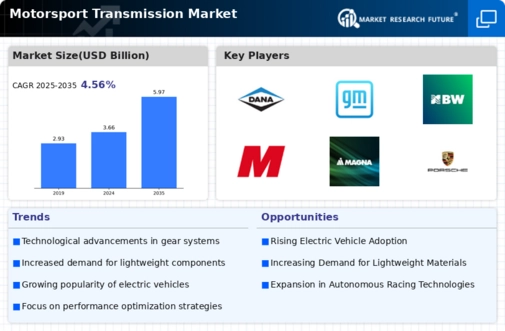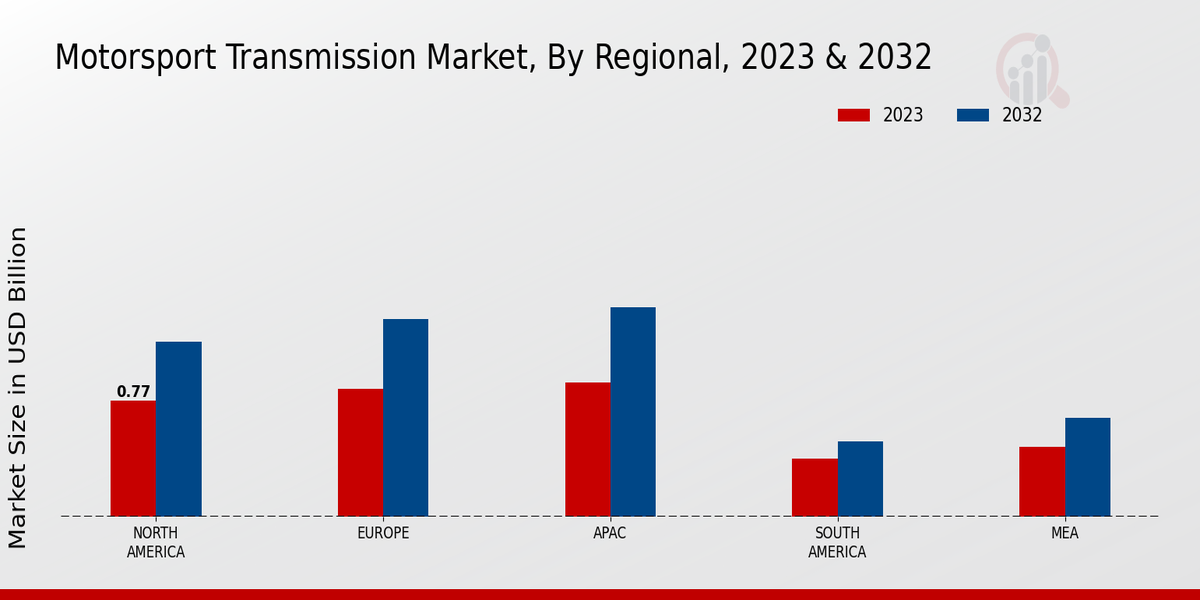Market Growth Projections
The Global Motorsport Transmission Market Industry is projected to experience substantial growth over the next decade. With a market value of 3.66 USD Billion anticipated in 2024, the industry is expected to expand at a CAGR of 4.55% from 2025 to 2035, ultimately reaching an estimated 5.97 USD Billion by 2035. This growth trajectory reflects the increasing demand for high-performance transmission systems driven by technological advancements, regulatory compliance, and the rising popularity of motorsports. As manufacturers continue to innovate and adapt to changing market dynamics, the industry is likely to witness a robust expansion, presenting numerous opportunities for stakeholders.
Technological Advancements
The Global Motorsport Transmission Market Industry is experiencing rapid technological advancements, particularly in the development of automated and semi-automated transmission systems. These innovations enhance vehicle performance and driver control, which are crucial in competitive motorsport environments. For instance, the integration of dual-clutch transmissions allows for quicker gear shifts, improving lap times. As teams seek every possible advantage, the demand for advanced transmission technologies is likely to increase, contributing to the market's growth. By 2024, the market is projected to reach 3.66 USD Billion, reflecting the industry's commitment to leveraging technology for performance enhancement.
Increased Investment in R&D
Investment in research and development is a critical driver for the Global Motorsport Transmission Market Industry. As teams and manufacturers strive for competitive edge, they allocate substantial resources to develop cutting-edge transmission technologies. This focus on R&D fosters innovation, leading to the creation of lightweight materials and more efficient transmission designs. For instance, advancements in carbon fiber technology have enabled the production of lighter and stronger transmission components, enhancing overall vehicle performance. This trend is expected to continue, with a projected CAGR of 4.55% from 2025 to 2035, indicating a sustained commitment to innovation within the industry.
Growing Popularity of Motorsports
The Global Motorsport Transmission Market Industry benefits from the increasing popularity of motorsports worldwide. Events such as Formula 1, NASCAR, and MotoGP attract millions of fans, driving demand for high-performance vehicles equipped with advanced transmission systems. This growing interest not only boosts viewership but also encourages manufacturers to invest in innovative transmission solutions. As motorsport events expand into new regions, the market is expected to see a surge in demand for specialized transmission systems tailored to various racing formats. This trend indicates a robust growth trajectory, with projections suggesting the market could reach 5.97 USD Billion by 2035.
Emerging Markets and Global Expansion
The Global Motorsport Transmission Market Industry is poised for growth due to the emergence of new markets and global expansion efforts. Countries in Asia and South America are increasingly investing in motorsport infrastructure and events, creating new opportunities for transmission manufacturers. This expansion not only increases the customer base but also encourages local teams to adopt advanced transmission technologies. As these markets develop, they are likely to contribute significantly to the overall market growth, with projections indicating a potential market size of 5.97 USD Billion by 2035. This trend underscores the global nature of motorsport and the interconnectedness of the transmission market.
Regulatory Compliance and Safety Standards
The Global Motorsport Transmission Market Industry is influenced by stringent regulatory compliance and safety standards imposed by governing bodies. Organizations like the FIA and FIM enforce regulations that mandate specific transmission technologies to enhance safety and performance. Compliance with these standards often necessitates the adoption of advanced transmission systems, which can lead to increased costs but also drives innovation. Manufacturers are compelled to develop solutions that not only meet regulatory requirements but also provide competitive advantages on the track. This dynamic is likely to sustain market growth as teams prioritize safety and performance in their vehicle designs.












